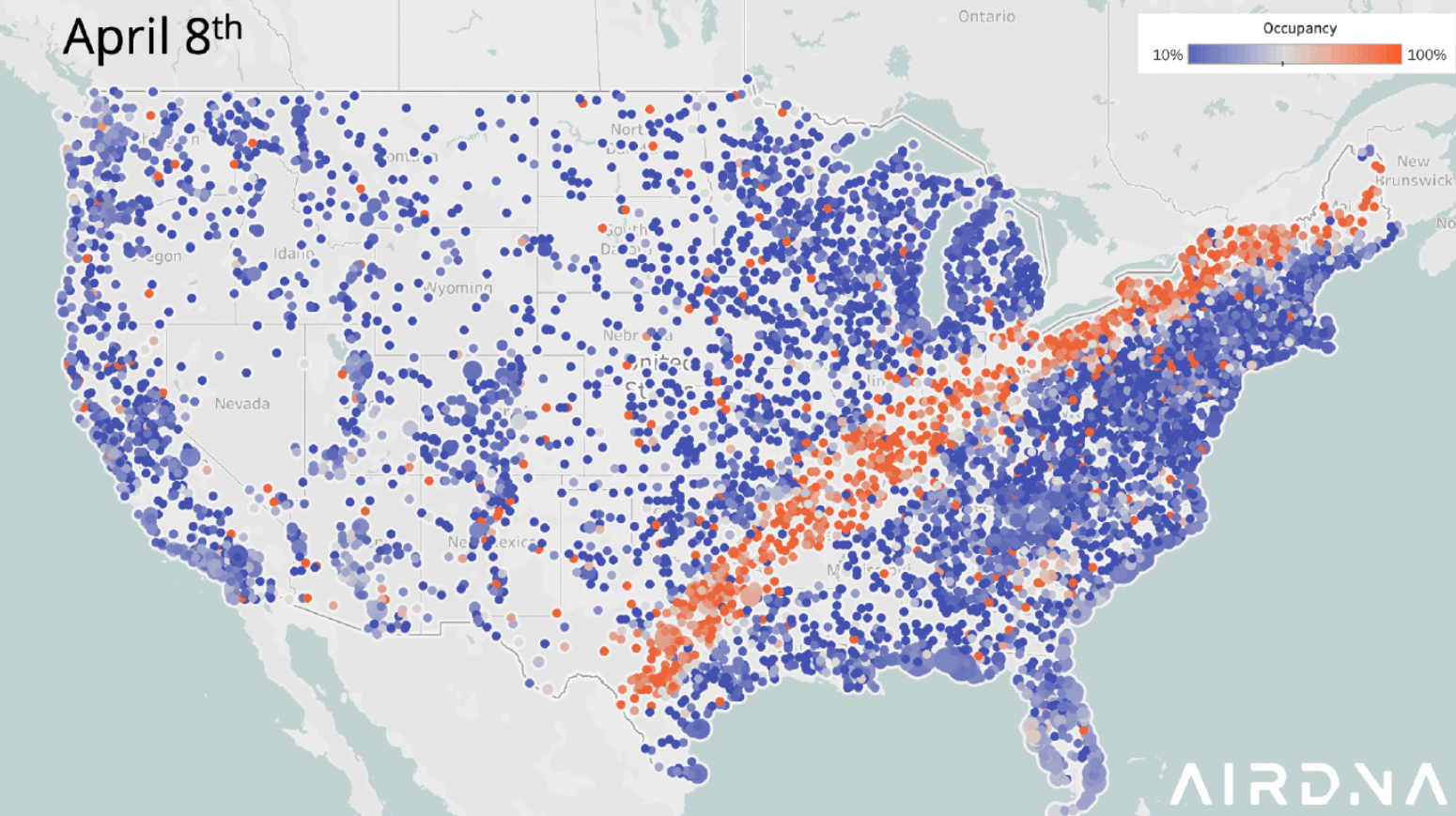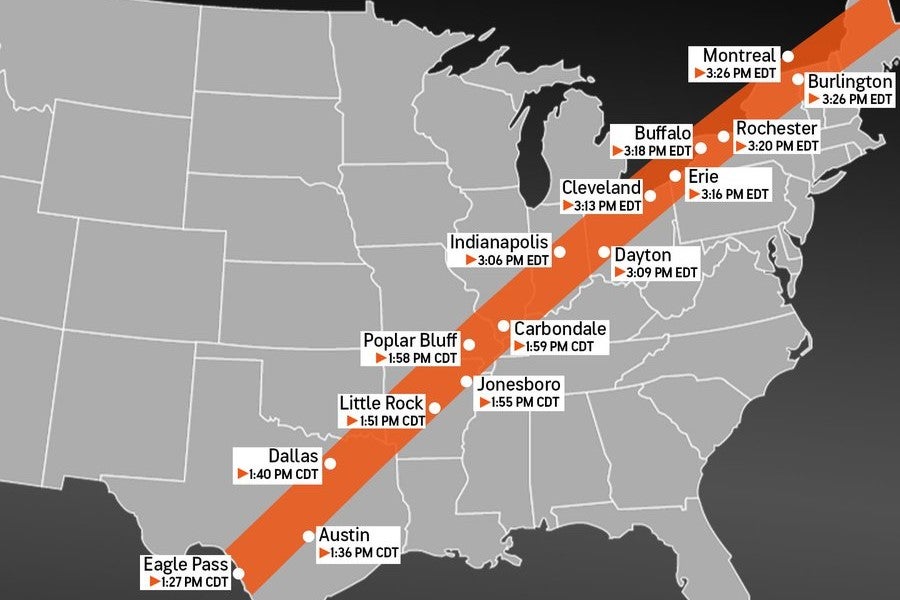Total solar eclipse 2024 highlights: Rare phenomenon darkens North America’s skies
Path of totality spans parts of Mexico, eastern Canada and 13 US states, as experts give information about how to safely see it and take pictures
Your support helps us to tell the story
From reproductive rights to climate change to Big Tech, The Independent is on the ground when the story is developing. Whether it's investigating the financials of Elon Musk's pro-Trump PAC or producing our latest documentary, 'The A Word', which shines a light on the American women fighting for reproductive rights, we know how important it is to parse out the facts from the messaging.
At such a critical moment in US history, we need reporters on the ground. Your donation allows us to keep sending journalists to speak to both sides of the story.
The Independent is trusted by Americans across the entire political spectrum. And unlike many other quality news outlets, we choose not to lock Americans out of our reporting and analysis with paywalls. We believe quality journalism should be available to everyone, paid for by those who can afford it.
Your support makes all the difference.A total eclipse of the Sun plunged a stretch of North America into darkness on Monday, with millions of spectators across the US, Mexico and Canada hoping to catch a glimpse of the rare event.
It was North America’s biggest eclipse crowd ever, with the path of totality crossing directly over 44 million people.
More were drawn in from across the world thanks to the lure of clear skies and up to four and a half minutes of midday darkness in some places.
Almost everyone in North America was guaranteed at least a partial eclipse, weather permitting.
The best weather was seen in Mexico and at the tail end of the eclipse in Vermont and Maine, as well as New Brunswick and Newfoundland.
“Cloud cover is one of the trickier things to forecast,” National Weather Service meteorologist Alexa Maines explained at Cleveland’s Great Lakes Science Centre on Sunday. “At the very least, it won’t snow.”
Solar eclipse 2024 live: Map of Airbnb bookings copy path of totality
You don’t need Nasa to tell you where in the US is going to get a total eclipse - you can just look at bookings on Airbnb.
Data gathered by AirDNA shows a massive spike in short-term rentals on platforms like Airbnb on 7 April and 9 April, as tourists hopeful of getting the best view of the solar eclipse flocking to the path of totality.
We’ll have an update of the latest weather forecast soon, but it looks like many of those making the bookings will be disappointed.

Solar eclipse 2024 live: Where to watch in the UK
A reminder that it is not only in North America that the solar eclipse will be visible. Partial obscuration of the Sun will take place as far away as the UK and Ireland - thousands of kilometres away from the path of totality.
There will be a brief moment to witness it before sunset at around 8pm, with the partial solar eclipse crossing over the Republic of Ireland, Northern Ireland, Scotland, Wales and the west of England.
The best place to see it in the British Isles will be the west coast of Ireland. More than a third of the Sun will be covered in Galway, while Cork and Limerick will see around 20 per cent obscuration.
In England, just a tiny slice of less than one per cent of the Sun will be covered by the Moon in Liverpool and Manchester.
You can find out more about how to see the solar eclipse in the UK here.
Solar eclipse 2024 live: Weather forecast for path of totality
The UK Met Office has helpfully provided a graphic showing the weather forecast for the path of totality in the US for today’s solar eclipse.
There is heavy rain across much of the southern US, with both Austin and Nashville potentially facing at least partial cloud cover. Luckily, most other spots look like they will get clear skies.
“For many along the optimal path with weather will allow a good view,” the Met Office says.
Unfortunately for those in the UK and Ireland, the weather forecast is not looking so favourable.
Solar eclipse 2024 live: ‘A few minutes of cosmic perspective'
We’ve heard from astrophysicist Jonathan Blazek from Northeastern University in the US, who says that even those not directly beneath the path of totality will have the opportunity to gain a few minutes of “cosmic perspective” during Monday’s eclipse.
Professor Blazek tells The Independent that he is organising a viewing event on Northeastern’s Boston campus, which will see about 93 per cent totality.
The eclipse is a powerful reminder of our place in the Solar System. The Sun is such a constant in our lives that it is easy to forget that it is actually a very large star that is quite far away. When the Moon passes in front, it becomes a bit easier to grasp where we are and how we are just a small part of the whole.
Similarly, it is striking how lucky we are to get eclipses at all. The moon is barely large enough to block the full sun. If it were just a bit smaller, we could only ever get partial eclipses -- indeed, when the moon is in the more distant part of its orbit (which is not quite circular) we can only get an annular eclipse. I think most people (myself included) have a misleading mental model of the Earth, Moon, and Sun, probably informed by not-to-scale illustrations in which their separations are compressed to fit on a single page. In reality, the distances involved are enormous, and the alignment must be essentially perfect, like threading a needle.
I hope that it is inspiring for the students who come and that we all gain a few minutes of cosmic perspective.
Solar eclipse 2024 live: How to watch - and how not to watch
It’s always worth remembering that eye safety is very important when it comes to looking at the Sun, even when the Moon is partially in the way. If not, the Sun’s rays can permanently damage your eyesight.
This is something former US president Donald Trump seemed to forget during the last solar eclipse over the US in 2017. The reality TV star stared directly at the Sun with no protection over his eyes.

Not one to miss an opportunity for a shot at his rival, President Joe Biden shared a video on Instagram and X showing him in the same spot Trump stood seven years ago.
“An eclipse is worth marveling at,” he wrote. “But don’t be silly, folks – play it safe and wear protective eyewear.”
Solar eclipse 2024 live: ‘Montreal is going crazy'
As excitement builds in Montreal – the only big city in the zone of totality with clear skies – Montreal City News reporter Swidda Rassy has been speaking to The Independent.
“The city is going crazy for this total solar eclipse,” she says. “It’s been on the news for so long. The government and just everybody is pushing to get those safe solar eclipse glasses.”
Tourism is up in Montreal. The Montreal hotel occupancy rate is around 70 to 75 per cent. And that is way above the normal rate for April.
“There’s just so many people that I’ve spoke with from America, mostly from Connecticut, London and people are coming from around the world just to check out the solar eclipse,” Ms Rassy adds.
“The weather is beautiful. I think that’s one of the main reasons why a lot of people are here. It’s supposed to be clear, sunny skies. So, yeah, a lot of people are excited.”

Ms Rassy sympathised with eclipse chasers who have headed for Niagara Falls, 400 miles southwest, where cloud cover is expected.
“I know it’s such a disappointment because I did hear that Niagara Falls is supposed to be one of the best destinations,” she says.
“Sorry, to people who are going to go to Niagara Falls. But here in Montreal, the weather is great, and it feels like an underrated spot. This solar eclipse – it’s a nice one for the history books, for sure.”
Solar eclipse 2024 live: See the planets during the day
When the Moon moves in front of the Sun and the sky darkens, celestial features that you can normally only see at night will briefly be visible.
Jupiter, Mars, Saturn and Venus will all be nearby the Moon and the Sun, with Venus being particularly easy to spot.
View from Vermont: Jeffersonville overflowing with eclipse chasers – and syrup
The Lodge at Wyckoff Maple – just outside Jeffersonville, Vermont – was fully booked for the eclipse. Owner Tom Wyckoff hadn’t known the eclipse was coming until about a month ago, he’d assumed the rush in bookings had been for a local wedding.
He had just charged the regular rate – he’d been horrified to hear of other Airbnb hosts later that had cancelled bookings and upped prices four times higher once they realised they could make a lot of eclipse guests. Him and wife Karen put on a special pancakes and maple syrup eclipse morning breakfast for guests.
His son Jordan Wyckoff dipped his pancake directly into the fresh maple syrup coming from the Wyckoff Family Maple sugar house – it was the very end of the sugaring season, the last batch of syrup they were expecting to boil.

Jordan said his wife saw on the news that the weather was cloudier down south – “so everyone is driving up here”.
Last week there had been a late huge dump of snow, the local ski resort Smuggler’s Notch seeing snowboarder and skiers taking advantage of the fresh powder.
On Monday morning, it was blue sky sunshine and the snow was melting. Jordan said he was going to watch the eclipse from the porch with his kids – everyone was hoping the blue skies lasted until the afternoon. “We say around here, if you don’t like the weather, just wait five minutes.”

How the solar eclipse will impact the weather
The folks over at the US National Oceanic and Atmospheric Administration (NOAA) have shared an animation that shows just how much today’s solar eclipse will impact the heating of the Earth.
Incoming solar radiation will drop from above 700 watts per metre-squared to nearly zero when the Moon passes directly in front of the Sun.
“Scientists at NOAA GSL are calculating how much the moon will block incoming solar radiation, which impacts heating of the Earth and therefore the weather,” the US governemnt agency wrote in a post to X.
What time the solar eclipse begins
We’re about 90 minutes away from the total eclipse beginning in the US.
If you want to know the exact time that it starts where you are, here’s a handy map shared by Accuweather.


Join our commenting forum
Join thought-provoking conversations, follow other Independent readers and see their replies
Comments